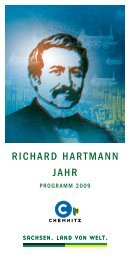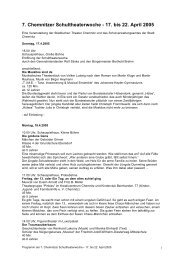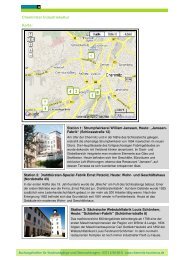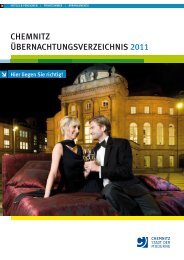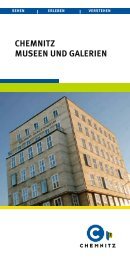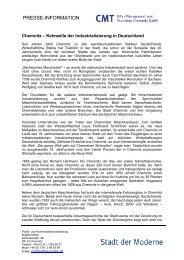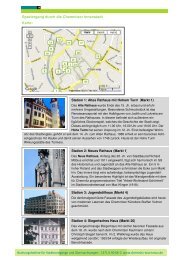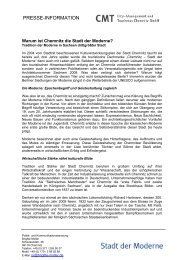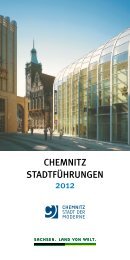Roter Turm - Konzept - Chemnitz Tourismus
Roter Turm - Konzept - Chemnitz Tourismus
Roter Turm - Konzept - Chemnitz Tourismus
Sie wollen auch ein ePaper? Erhöhen Sie die Reichweite Ihrer Titel.
YUMPU macht aus Druck-PDFs automatisch weboptimierte ePaper, die Google liebt.
<strong>Chemnitz</strong>/Cairo<br />
12008 n.Chr.<br />
Das Open-Air-Projekt<br />
`<strong>Roter</strong> <strong>Turm</strong> als Beduinenzelt’<br />
3. Juli - 4. Oktober 2008<br />
ANDREA TAHA IN ZUSAMMENARBEIT MIT<br />
ROTER TURM e.V., STADTPLANUNGSAMT CHEMNITZ, KULTURAMT CHEMNITZ,<br />
ROTER TURM e.V.<br />
Was wird in 10.000 Jahren von uns noch übrig sein?<br />
ARCHITEKTURSOMMER SACHSEN
“Ich habe mich lange<br />
genug mit Geschichte<br />
beschäftigt, um zu wissen,<br />
daß sie ständig neu<br />
geschrieben wird.”<br />
Bill Clinton, Präsident a. D.
ANDREA TAHA - CHEMNITZ 12008 N. CHR. / DER ROTE TURM ALS BEDUINENZELT 3. JULI - 4. OKTOBER 2008<br />
Was wird in 10.000<br />
Jahren von uns noch<br />
übrig sein?<br />
Die Ausgrabung der Jetztzeit: Andrea Taha macht immer etwas Besonderes. Sie geht neue Wege, hat neue<br />
Ideen. Man könnte es als “Idee-Kunst” bezeichnen. Sie hat nicht nur gute Ideen, sondern setzt sie auch<br />
genial um. Eine Kunst, der man eine gewisse Originalität nicht absprechen kann.<br />
Ihre fiktiven Zeichnungen, Collagen, Objekte und Projekte greifen auf eine Zeit voraus, die weit über unser<br />
Vorstellungsvermögen hinausgeht. Andrea Taha aber versucht treffsicher sich vorzustellen, was aus unserem<br />
Zivilisationsmüll wird, wenn er nach tausenden von Jahren ausgegraben wird. Sie nimmt Gegenstände aus<br />
dem Alltag - von der Cola-Büchse bis hin zu einem Lederball - und erfindet einen fiktiven wissenschaftlichen<br />
Text dazu. Und die Gegenstände werden auf "alt" gemacht, sozusagen "fossilisiert" und als<br />
Dokumentation präsentiert. Eine Besonderheit kommt noch dazu: einige Texte sind in arabischer Schrift<br />
geschrieben. Inhaltlich ist es eine Art Archäologie der Gegenwart, ausgegraben in der Zukunft, ein Paradox<br />
der Geschichte. Thomas Ranft/Vorsitzender Kunst für <strong>Chemnitz</strong> e.V.<br />
Versteinerter Fußball, Berlin 2006 Versteinerter Fernseher, Cairo 2008 Versteinerter Erzgebirgler, Pobershau 2007
ANDREA TAHA - CHEMNITZ 12008 N. CHR. / DER ROTE TURM ALS BEDUINENZELT 3. JULI - 4. OKTOBER 2008<br />
Transformation<br />
eines Symboles<br />
12008 n.Chr.<br />
Die Verwandlung des Roten <strong>Turm</strong>es in ein Beduinenzelt soll verdeutlichen, wie sich Symbole im Laufe<br />
der Zeit verändern, wie sich kulturelle Einflüsse ausbreiten, wie sich Wohngewohnheiten verändern.<br />
Wir befinden uns im Jahre 12008 n. Chr.: Besucher stehen vor dem Roten <strong>Turm</strong> zu <strong>Chemnitz</strong>. Der <strong>Turm</strong><br />
hat sich in ein Zelt mit fremdländischen Ornamenten verwandelt. Vor dem <strong>Turm</strong> ist eine grosse Sanddüne<br />
angeweht als fiktives Zeichen der Klimaveränderung. Dort befindet sich auch das Cafe “Transformation”,<br />
in dem man sich niederlässt, etwas trinkt und kulturelle Veranstaltungen geniesst.<br />
vorher nachher
ANDREA TAHA - CHEMNITZ 12008 N. CHR. / DER ROTE TURM ALS BEDUINENZELT 3. JULI - 4. OKTOBER 2008<br />
Texttafeln<br />
RUND UM DAS BEDUINENZELT WERDEN IM SAND<br />
ARCHAOLOGISCHE TEXTTAFELN INSTALLIERT.<br />
Reste der<br />
‘Sphinx’<br />
<strong>Chemnitz</strong>/Cairo, um 12008 n. Chr.<br />
Um nicht in den Fluten des Nil-Staudammes zu versin-<br />
ken, wurde die Sphinx aus Cairo um 1964 n. Chr. in einer<br />
beispiellosen Rettungsaktion in das höher gelegene<br />
<strong>Chemnitz</strong> verlegt. Aus bisher ungeklärten Gründen wurde<br />
sie zudem mit einer kupfernen Ummantelung umgeben,<br />
die Sandsteinreste der Sahara verflüchtigten sich im<br />
Laufe der Jahrtausende.<br />
Leider veränderten sich durch diese Prozesse die<br />
Gesichtszüge stark, so dass es in Expertenkreisen jahr-<br />
zehntelang zu der Annahme kam, es handele sich bei der<br />
Abbildung um Karl Marx.<br />
Was wird in<br />
10.000 Jahren<br />
von uns noch<br />
übrig sein?<br />
<strong>Chemnitz</strong>, um 12008 n. Chr.<br />
Nach mehreren Meteoriteneinschlägen änderte sich das<br />
europäische Klima nachhaltig. Verfestigte Ascheablager -<br />
ungen wurden bis ca. 9000 n. Chr. von vordringenden<br />
Meeresströmungen zerkleinert. Später versandete die<br />
Gegend, Nomadenvölker bevölkerten die Gegend.<br />
Um 12008 n. Chr. entdeckten Experten Reste einer Stadt,<br />
die auf ca. 280.000 Einwohner geschätzt wurde. An dieser<br />
Stelle stand möglicherweise eines der ältesten Bauwerke,<br />
der so genannte ‘Rote <strong>Turm</strong>’ oder ‘Rothe thorm’. Auf Grund<br />
bauhistorischer Untersuchungen und neuerer Erkenntnisse<br />
der Besiedlungsgeschichte kann sein Alter mit 10850<br />
Jahren angegeben werden.<br />
Ursprünglich bestanden seine Mauern aus rotem Porphyr,<br />
der aus Steinbrüchen der Umgebung gewonnen wurde. Seine<br />
Höhe betrug 38 Meter, seine Breite schätzen die Experten<br />
auf 10 Meter.
ANDREA TAHA - CHEMNITZ 12008 N. CHR. / DER ROTE TURM ALS BEDUINENZELT 3. JULI - 4. OKTOBER 2008<br />
Lageplan<br />
<strong>Roter</strong> <strong>Turm</strong><br />
(Grundfläche 8,31 x 8,36 m)<br />
´Sanddüne´<br />
(ca. 20 m lang,<br />
max. 12 m breit)<br />
Original Beduinenzelt<br />
(Grundfläche Durchmesser 7m)
ANDREA TAHA - CHEMNITZ 12008 N. CHR. / DER ROTE TURM ALS BEDUINENZELT 3. JULI - 4. OKTOBER 2008<br />
Belebung der Innenstadt<br />
Das Projekt als Anziehungspunkt für<br />
Besucher als auch Bewohner unserer<br />
Stadt - Kulturelle Veranstaltungen im<br />
Beduinenzelt in Zusammenarbeit mit<br />
dem Architektursommer Sachsen, den<br />
Interkulturellen Wochen, Städtischen<br />
Theatern, anderen Kultureinrichtungen,<br />
dem City Management sowie der Galerie<br />
<strong>Roter</strong> <strong>Turm</strong><br />
- Bewirtung im Beduinenzelt während<br />
des Sommers 2008
ANDREA TAHA - CHEMNITZ 12008 N. CHR. / DER ROTE TURM ALS BEDUINENZELT 3. JULI - 4. OKTOBER 2008<br />
Beduinenenzelt<br />
Veranstaltungsort, Cafe<br />
Material: Polyester-Baumwoll-Mischgewebe<br />
doppel genäht, in der Mitte Futterstoff aus Baumwolle (siehe Muster)<br />
- spezialbehandelt gegen Feuer<br />
- im Dach extra Folie eingenäht<br />
- Holzpfosten (Hartholz - siehe Muster) eingenäht<br />
- Mittelpfosten Pfostenstärke<br />
Detailansicht Eingansbereich
ANDREA TAHA - CHEMNITZ 12008 N. CHR. / DER ROTE TURM ALS BEDUINENZELT 3. JULI - 4. OKTOBER 2008<br />
Beduinenenzelt<br />
Skizzen<br />
Aufgeklappte<br />
Tür<br />
2,60 m<br />
(Vogelperspektive)<br />
7 m<br />
Betonklotz als Befestigung<br />
2,60 m 4,50 m<br />
Mittelpfosten<br />
4,50 m<br />
(Seitenansicht)
ANDREA TAHA - CHEMNITZ 12008 N. CHR. / DER ROTE TURM ALS BEDUINENZELT 3. JULI - 4. OKTOBER 2008<br />
Grundriß und Betriebsbeschriebung<br />
Gastronomie<br />
- Sitzplätze für maximal 40 Personen<br />
- einfache Ausgabeküche mit XXX Portionen<br />
- einfache Gerichte wie Würstchen, Sandwich, Fingerfood, Getränke<br />
- Tresen im Zelt<br />
- Öffnungszeiten täglich von 11 bis 21 Uhr, nicht bei schlechtem Wetter<br />
- Toilettenbenutzung in der Galerie <strong>Roter</strong> <strong>Turm</strong><br />
Aufgeklappte<br />
Tür<br />
2,60 m<br />
Sitzflächen<br />
Tische<br />
Tresen
ANDREA TAHA - CHEMNITZ 12008 N. CHR. / DER ROTE TURM ALS BEDUINENZELT 3. JULI - 4. OKTOBER 2008<br />
Grundriß und Betriebsbeschriebung<br />
Gastronomie<br />
- mögliche Anordnung bei Versammlungen oder Veranstaltungen<br />
Aufgeklappte<br />
Tür<br />
2,60 m<br />
Sitzflächen<br />
Tische<br />
Tresen
Andrea Taha M.A./Concept artist:<br />
1968 born in <strong>Chemnitz</strong>, 1987 A-levels, 1988 Craftswoman for printing technology in Leipzig, 1989 university<br />
studies in Halle/Burg Giebichenstein, 1990-1994 studies in Vienna (University for Applied Arts,<br />
master class Luerzer, graduation with honours, Austrian Würdigungspreis (award for outstanding academic<br />
records), 1995 member of the Creativ Club Austria (12 Veneri, Printissimo (awards of the advertising<br />
industry), award at the New York Festival), until 2000 job as copywriter and conceptual designer at<br />
renowned advertising agencies in Vienna and Frankfurt/Main, since 2000 Beduinenzelt®, since 2005<br />
Member of the German Association of Artists, since 2005 member of “Kunst für <strong>Chemnitz</strong> e.V.”
“Kunst für <strong>Chemnitz</strong>” 1994–2008<br />
The association “Kunst für <strong>Chemnitz</strong>” was founded in the autumn of 1994. At this time, a few years after the fall of the Berlin<br />
Wall, one could feel also here in <strong>Chemnitz</strong> the atmosphere of renewal which set in after the political transformation of Eastern<br />
Germany, the former GDR. The will of many individuals to shape and create things was very tangible.<br />
Consequently, many cultural and artistic projects, ideas, and visions have their roots in this period – among others the ven-<br />
ture to establish an association for the advancement of art and artists in <strong>Chemnitz</strong>. The impetus for the foundation of this<br />
association came from three principal sources: the business community of <strong>Chemnitz</strong>, represented by Michael Windesheim and<br />
Willi Schneider, the art scene centered around the renowned Galerie Oben which was very sympathetic to the project right<br />
from the start; here we may mention Gregor-Torsten Kozik, Michael Morgner, Thomas Ranft, Klaus Süß, Steffen Volmer and<br />
Carsten Nicolai. Last but not least, the directors of theatres and museums who realized the potential which lay in the bund-<br />
ling of artistic resources and who contributed their ideas at an early stage, even before the association was founded.<br />
It’s impossible to resume in a few lines everything the association has accomplished since 1994 through voluntary activity. It<br />
may suffice to mention some impressive numbers to document its continuous commitment during the last decade: 34 exhibi-<br />
tions have been presented in <strong>Chemnitz</strong> and other cities, 31 placards have been produced for new productions of the Theater<br />
<strong>Chemnitz</strong>, two valuable maps with original prints have been edited, eight art catalogues have been published, six art tours<br />
have been undertaken and countless public events have been organized in the HECK-ART-Haus. Resuming the first decade of<br />
its existence, Michael Windesheim, one of the founding initiators of the association, writes in the preface to this documenta-<br />
tion: “The HECK-ART-Haus – a living ‘Gesamtkunstwerk’, encompassing a gallery and a re staurant with Mediterranean cuisine<br />
– is our ‘Denkfabrik Zukunft’ which has confirmed itself as a catalyst for communication and as a platform for the fertile<br />
exchange between economy and culture.”<br />
This anniversary is also an occa sion to look forward, to collect ideas for the next ten years, and to build on the jointly laid<br />
groundwork in a meaningful and adequate manner. The coming objectives are also big ones: in the year 2005 the association<br />
will be guest in England. This time with the double exposition “clara mosch & sons ltd” at the gallery of the Manchester<br />
Metropolitan University and at the German Embassy in London. It will present on the one hand a retrospective about the arti-<br />
stic group and producers’ gallery clara mosch from <strong>Chemnitz</strong>, and give on the other hand an insight into contemporary East<br />
German art studios. Next year the Kunstsammlungen <strong>Chemnitz</strong> will dedicate an important retrospective to the artist and hono-<br />
rary member of the association Carlfriedrich Claus (passed away in 1998) on the occasion of his 75th anniversary.<br />
“Kunst für <strong>Chemnitz</strong>” and its “Freundeskreis Kunst für <strong>Chemnitz</strong>” (a circle of friends of the association founded in 1998,<br />
encompassing about 30 art promoters) will not lack ideas in the future. If the broad public support and acceptance of the<br />
first de cade as well as the enthusiasm of the initiators will remain as strong as in the past, there’s no need to worry about<br />
the next ten years.
<strong>Konzept</strong>: Andrea Taha M.A.<br />
Realisation: Andrea Taha M. A., Khaled Taha<br />
Projektmanagement: Michael Windesheim (Vorsitzender <strong>Roter</strong> <strong>Turm</strong> e.V.)<br />
Thomas Ranft (Vorstandsmitglied <strong>Roter</strong> <strong>Turm</strong> e.V.)<br />
Johanna Maske (Kunst für <strong>Chemnitz</strong> e.V.)<br />
ROTER TURM e.V.<br />
<strong>Roter</strong> <strong>Turm</strong> e.V. � Mühlenstrasse 2 � D-09111 <strong>Chemnitz</strong> � � � �<br />
Tel./Fax: 00 49 (0) 371 / 644 67 66 � � e-Mail: post@kunstfuerchemnitz.de � � � �<br />
� � � � � � � www.kunstfuerchemnitz.de



